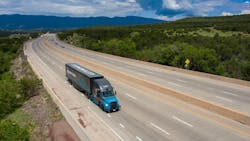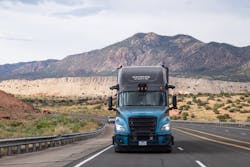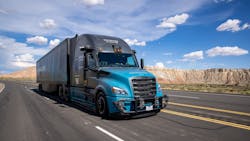Daimler Truck, Torc work to commercialize autonomous trucks
In their third year of collaboration, Torc Robotics and Daimler Truck are working to commercialize the first scalable, profitable Level 4 autonomous truck that is aimed to help fleets improve their operations. Torc is testing the Level 4 trucks on public roads in Virginia, New Mexico, and Texas, with continued route expansion in the works.
Through the partnership, the two companies are pursuing a "focused, safety-oriented approach." According to Peter Vaughan Schmidt, head of the autonomous technology group at Daimler Truck, introducing technology into an existing infrastructure, where human drivers will share the road with automated trucks, requires credibility and responsibility.
“As the inventor of the truck, Daimler Truck has many decades of experience in testing and validation of commercial vehicles,” Vaughan Schmidt said. “Nevertheless, to develop a safe autonomous Level 4 truck remains a complex task and resembles a marathon, not a sprint. Two years together with Torc Robotics, we have accomplished a lot, collaboratively pursuing a common goal of leading the logistics sector into the future and making road traffic safer for society.”
Expanded real-world testing
Daimler Truck and Torc formed their alliance when Daimler invested in a majority share in Torc in August 2019. Torc operates as an independent subsidiary and serves as the lead for autonomous system development, innovation, and testing with Daimler Truck's internal self-driving truck efforts.
In addition to testing in other regions, Torc manages a fully operational test facility in Albuquerque, New Mexico, running multiple routes and shifts each day. Last year, Torc expanded on-road testing in the Southwest into Texas. Additional routes are planned and based on major freight haulage.
Torc CEO Michael Fleming described how Torc’s pure-play approach will work to generate trust among all parties. “We are concentrating on one OEM truck platform (Daimler Trucks North America’s Freightliner Cascadia), one business case (long-haul trucking), and one environment (U.S. interstate highways),” Fleming said. “Commercializing self-driving trucks is a very complex endeavor, and we are first solving the least complex use case, then expanding our product reach as the technical capabilities are proven. I am absolutely convinced that Torc will be the first company to develop a profitable, scalable product in the autonomous truck space. We move to the next level of complexity when we have proven our program.”
Partnerships with industry experts
Meanwhile, Torc and Daimler Truck are building partnerships with other technology-forward companies.
“Part of our pure-play approach is to do what we do best and work with others who bring best-in-class solutions,” Fleming explained. “This helps us accelerate our development. This past year, Daimler announced a strategic partnership with Luminar for collaborative development of long-range, hi-fidelity lidar for autonomous trucking and Torc selected AWS as Torc’s preferred cloud provider for data handling.”
"Commercializing a self-driving truck is one of the most challenging engineering feats of our generation," Fleming said. To accomplish this, Torc has been growing since partnering with Daimler Truck and has more than doubled its workforce. Torc has also added power players to its leadership team, with the addition of NASA safety expert John Marinaro as director of operational safety and testing, veteran tech strategist Eddie Amos as chief transformation officer, and technology marketer Jane Bailey as vice president of marketing and communications.
Reinventing the truck
Daimler Trucks North America is working to reinvent the truck chassis to integrate with autonomous vehicle systems, adding redundancies for safety-critical components like steering, braking, and powernet.
The Torc team continues developing software, testing, and systems integration. According to the company, developing a vehicle capable of safely and reliably executing commands given by an autonomous driving system requires a fundamentally different approach. Safety-critical components must be designed to detect a failure and invoke redundancy to safely execute its maneuvers, Torc stated. Should any of the most relevant systems encounter a fault, the Level 4 system needs to be able to monitor, assess and deploy backup systems to safely control the truck, the company added


